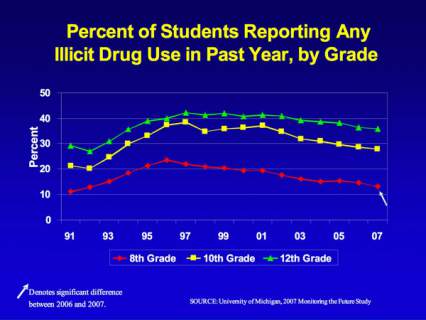The Good News
- Overall, the results are very positive -
- From 2006 to 2007, the percentage of 8th graders reporting lifetime use of any illicit drug declined from 20.9% to 19.0%.
- Reported past year use among 8th graders declined from 14.8% to 13.2%.
- Past year prevalence has fallen by 44% among 8th graders since the peak year of 1996.
- Past year prevalence has fallen 27% among 10th graders and 15% among 12th graders since the peak year of 1997.
- Cigarette smoking continues to fall to the lowest rate in the survey's history. Between 2006 and 2007, declines were observed in lifetime, past month, and daily cigarette use among 8th graders. Although there were no 1-year declines for 10th and 12th graders, all grades have continued a longer term trend of declining cigarette use. 1
- Past year use of marijuana by 8th graders declined from 11.7% in 2006 to 10.3% in 2007. Between 2001 and 2007, past month marijuana use declined by nearly 25% for 8th, 10th, and 12th graders combined.
- Since 2006, past year steroid use decreased in 8th, 10th, and 12th graders combined from 1.3% to 1.1%.
- Methamphetamine abuse continues to decline - between 2006 and 2007, lifetime and past year use among 8th and 12th graders decreased.
- A substantial long-term decline was observed in past year alcohol use among 8th graders, down to 31.8% from its peak of 46.8% in 1994. Additionally, past year use of flavored alcoholic beverages among 10th graders decreased from 48.8% in 2006 to 45.9% in 2007.
Areas of Concern
- In 2007, 15.4% of 12th graders reported using a prescription drug nonmedically within the past year2. Vicodin continues to be abused at unacceptably high levels.
- Attitudes toward substance abuse, often seen as harbingers of change in abuse rates, were mostly stable. However, among 8th graders, perceived risk of harm associated with MDMA decreased for the third year in a row. Attitudes towards using LSD also softened among 10th graders this year.
- Between 2005 and 2007, past year abuse of MDMA increased among 12th graders from 3.0% to 4.5%; and between 2004 and 2007, past year abuse of MDMA increased among 10th graders from 2.4% to 3.5%.
Notes:
1. These findings are particularly noteworthy since tobacco addiction is one of the leading preventable contributors to many of our Nation's health problems.
2. This category includes amphetamines, sedatives/barbiturates, tranquilizers, and opiates other than heroin.

